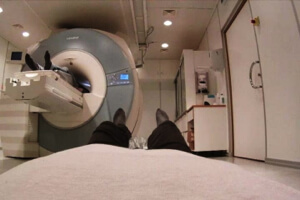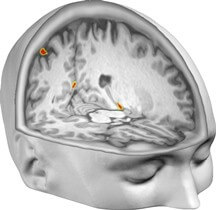With the help of modern brain scanning technology, scientists have begun methodically mapping the brain by asking people to perform tasks or inducing experiences in a scanning machine and recording brain activity to see which regions are active. Now, such research is rising above the mundane.

A new study induced out-of-body illusions in 15 healthy people to see which part of the brain lit up.
Most of the time, our sense of self is tightly tied to the body. But it isn’t so tightly tied that our brain can’t be fooled. One recent virtual reality experiment, for example, removed the body completely, effectively creating the illusion of invisibility. Others have transported users into another person’s body entirely.
The Karolinska Insitutet study gave participants a headmounted display and showed them eyewitness video from another body across the room. In the video, their own body was visible poking out from the scanning machine in the background. The researchers then touched both bodies at the same time, in the same way, while the touches to the participants’ own bodies were hidden from view to enhance the illusion.
Arvid Guterstam, the study’s lead author, says, “In a matter of seconds, the brain merges the sensation of touch and visual input from the new perspective, resulting in the illusion of owning the stranger’s body and being located in that body’s position in the room, outside the participant’s physical body.”
The team tested the strength of the illusion by threatening to injure the stranger’s body. They found that when the illusion was successful, the stress response to the other body being threatened was more intense than when the illusion was “broken.” And when the participant’s own body was threatened, the stress response was lower than expected—as if the participant was watching another person’s body instead.
After establishing the illusion, the researchers “teleported” participants between bodies with different perspectives in various parts of the room. Analyzing brain activity in the temporal and parietal lobes, they found they could decode which perspective (or “perceived self location”) a person was experiencing. They also showed a relationship between these patterns and the vividness of the illusion in a given position.
In an earlier Nobel Prize winning experiment with rats, scientists had discovered specialized cells (“place cells”) in the hippocampus that signal the rat’s position in space—a kind of GPS for the brain. The hippocampus was one of the active self-locating regions in this more recent study. This may suggest place cells are used not only in navigation and memory, but also help generate a sense of being a body in space.

“The sense of being a body located somewhere in space is essential for our interactions with the outside world and constitutes a fundamental aspect of human self-consciousness,” says Guterstam. “Our results are important because they represent the first characterization of the brain areas that are involved in shaping the perceptual experience of the bodily self in space.”
Research projects like this one also show how applications for the virtual experiences provided by headmounted displays may stretch beyond just entertainment to many different fields. For the purposes of brain research, it allows scientists to more rigorously test how the brain responds to various real or illusory situations.
Beyond pure research, body swap illusions might put us in someone else’s shoes to increase our empathy towards them. Or they might be a useful therapy. An interesting finding of the invisibility illusion study was that participants were less socially anxious standing in front of an audience when under the illusion.
More broadly, however, the research shows how dependent we are on the brain’s interpretation of the world—and no matter how permanent or natural it feels—just how pliable that perspective can be.
Image Credit: Shutterstock.com; Malin Björnsdotter/Arvid Guterstam (Karolinska Institutet)



